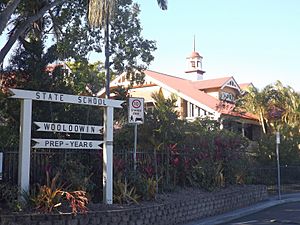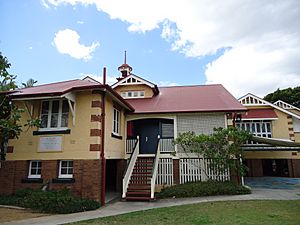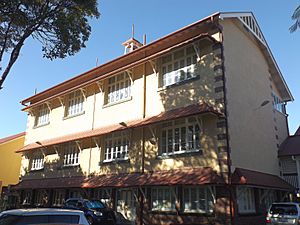Wooloowin State School facts for kids
Quick facts for kids Wooloowin State School |
|
|---|---|

Wooloowin State School, 2015
|
|
| Location | 663 Lutwyche Road, Wooloowin, City of Brisbane, Queensland, Australia |
| Design period | 1900–1914 (early 20th century) |
| Built | 1914–1934 |
| Official name: Wooloowin State School | |
| Type | state heritage (built) |
| Designated | 13 January 1995 |
| Reference no. | 601565 |
| Significant period | 1914–1930s (historical) 1914–1930s (fabric) 1914–ongoing (social) |
| Significant components | school/school room, classroom/classroom block/teaching area |
| Lua error in Module:Location_map at line 420: attempt to index field 'wikibase' (a nil value). | |
| Wooloowin State School | |
|---|---|
| Address | |
|
663–665 Lutwyche Rd, Lutwyche
, |
|
| Information | |
| Type | Public, co–educational, primary |
| Motto | Manners Maketh Man |
| Established | 12 September 1914 |
| Principal | Chris Hansen |
| Grades | Prep to Year 6 |
| Number of students | 250 (approx.) |
| Campus | Suburban |
| Colour(s) | Navy blue, light blue and white |
Wooloowin State School is a historic public primary school in Wooloowin, Brisbane, Queensland, Australia. It was built in stages between 1914 and 1934. The school is recognized for its importance and is listed on the Queensland Heritage Register.
Contents
History of Wooloowin State School
Wooloowin State School was built in four main parts. The first section was finished in 1914. More parts were added in 1918, 1925, and 1934. When it first opened, it was seen as a "model school." This meant it was a great example of modern education in Queensland. Everything about it, from the buildings and grounds to the furniture and lessons, was top-notch.
How Wooloowin Grew
The area of Wooloowin was originally part of Lutwyche. It got its name from the Wooloowin railway station, which opened in 1889. In the 1880s, large land areas were divided into smaller blocks for homes. The area really grew in the early 1900s. This was especially true after the tram line was extended to Kedron in 1913–1914. Wooloowin became a busy place for working-class families to live.
In 1911, a group called the Wooloowin Progress Association was formed. They worked hard to get a school built. Before 1914, children from Wooloowin had to go to crowded schools in Eagle Junction and Bowen Bridge Road.
The government bought a three-acre piece of land for £1,200. Plans for the new school were drawn up in 1913 by the Government Architect's Office.
Designing a Model School
Alfred Barton Brady was the Government Architect for Queensland from 1892 to 1922. He worked with a talented team of architects. They designed many important government buildings across Queensland. This included post offices, customs houses, and courthouses. The Government Architect's office also designed schools. Some famous early 20th-century schools they designed include East Brisbane State School and Windsor State School. Like Wooloowin, Windsor State School was also built as a "model school."
Wooloowin State School was quite expensive for its time, costing £3,901. It was meant to be a "show" school. The foundation stone was laid in 1914 by James Blair, who later became a very important judge. The school opened on September 15, 1914, with 266 students.
The first building had four large classrooms. They were in two brick wings with wide verandahs. The school had modern desks for two students, with seats that could tip up. It also had large green "blackboards" instead of old boards on easels. The teachers chosen for this school were some of the best in Queensland.
New Ideas in Education
Wooloowin State School was built during a time of new ideas in education in Queensland. In 1914, the first teacher training college opened in Brisbane. A new school curriculum was introduced in 1915. This new plan focused on making subjects connect to each other. It also encouraged students to learn by doing things themselves.
The new curriculum included "kindergarten occupations" for younger children. School gardening became a formal subject. Manual training (like woodworking) and domestic science (like cooking and sewing) were also encouraged. Needlework became a required subject for girls. Schools started to focus on developing the whole child, not just on memorizing facts.
Sports and Practical Skills
A big part of modern education was encouraging sports, especially swimming. In 1908, teachers formed a group to promote swimming for school children. By 1914, many swimming clubs had started. These clubs taught swimming and even life-saving skills.
The Wooloowin State School building committee wanted their school to be very modern. So, they paid for a swimming pool to be built in 1916. It was 42 feet long and 16 feet wide. This pool was made even bigger in 1925.
In 1918, woodworking and domestic science were added to the school's lessons. Wooloowin was one of the first primary schools to offer these subjects.
School Buildings and Changes
The first addition to the school was built in 1918. It was a brick building that looked similar to the original 1914 wing. This added two more classrooms, bringing the total to six.
By 1921, the school had grown to over 800 students. So, in 1923, plans were made for a second addition. This was a two-storey brick building with four classrooms on each floor. It was built in 1925 and cost £6,233.
Wooloowin continued to grow in the 1920s and 1930s. More people moved to the area. By the early 1930s, the school needed more space again. In 1934, a three-storey brick wing was built. This new building had wide balconies on each floor. The upper floors had classrooms. The ground floor had special rooms for domestic science and manual training. Students from other schools, like Windsor State School, even came to Wooloowin for these classes.
The 1934 building was the last major addition. In the second half of the 20th century, the number of students at Wooloowin State School slowly went down. This was because the area around the school changed, with more older people living there.
In 2015, the school had about 297 students from Prep to Year 6. It had 25 teachers and 15 other staff members.
School Building Design
The school buildings from 1914, 1918, and 1925 are connected. They form a group of one and two-storey classroom blocks. These buildings are made of masonry (like brick) and have play areas underneath. Most of the outside walls have a rough finish called "roughcast render." The original roofs were made of red asbestos slates, but these have been replaced with corrugated iron. Each part of the school has its own roof, with vents and skylights.
The 1934 addition is a three-storey masonry building. It has a mix of face brick and roughcast render, matching the older buildings. Its original red asbestos slate roof has also been replaced with corrugated iron.
Except for the new roofs, the outside of the school buildings looks very much like it did when it was first built.
Why Wooloowin State School is Important
Wooloowin State School is listed on the Queensland Heritage Register because it is important for several reasons:
- Showing History: It shows how education changed in Queensland in the early 1900s. It was built as a "show" school, meaning it was a great example for other schools. The high quality of its buildings, furniture, and lessons set a standard. The school also shows how quickly Wooloowin grew. This growth happened because of new public transport, like the tram line, and a scheme that helped working-class families buy homes.
- Typical School Design: It is a great example of a school building designed for Queensland's climate. It has wide verandahs and a special roof that helps with ventilation. It also shows the high quality of buildings designed by the Queensland Public Works Department. The use of brick and simple details was common for government buildings of that time.
- Beautiful Design: Wooloowin State School is also important because of its beautiful design. It was designed by the Queensland Government Architect's office, which was one of the best in Australia. Its simple shape, roughcast walls, and wide roofs with gables and vents make it a great example of its style.
See also



